Spring Transaction源码分析
2021-03-20 00:26
标签:bean getc dea bsp 注册 wing mat data string 以最简单的jdbc事务为例: TxNamespaceHandler.init: 明显解析的入口便在AnnotationDrivenBeanDefinitionParser.parse: 下面分部分进行说明。 第一部分用于向Spring容器注册TransactionalEventListener工厂,TransactionalEventListener是Spring4.2引入的新特性,允许我们自定义监听器监听事务的提交或其它动作。 即configureAutoProxyCreator方法,此方法的最终作用便是在Spring容器中加入这样的bean结构: BeanFactoryTransactionAttributeSourceAdvisor->TransactionInterceptor->AnnotationTransactionAttributeSource 其中AnnotationTransactionAttributeSource用于解析@Transactional注解的相关属性。 与aop模块类似,入口位于configureAutoProxyCreator里注册的bean: InfrastructureAdvisorAutoProxyCreator,其类图: 此类的特殊之处从其名字上可以体现: 只考虑Spring内部使用的基础设施Advisor。 为类创建代理的入口位于AbstractAutoProxyCreator.postProcessAfterInitialization: wrapIfNecessary核心逻辑: getAdvicesAndAdvisorsForBean用于去容器中寻找适合当前bean的Advisor,其最终调用AbstractAdvisorAutoProxyCreator.findEligibleAdvisors: 这个方法在spring-aop中已经详细说明过了,这里再强调一下具体的查找逻辑: 对于spring事务来说,我们有唯一的Advisor: BeanFactoryTransactionAttributeSourceAdvisor,其类图: 可以看出,BeanFactoryTransactionAttributeSourceAdvisor其实是一个PointcutAdvisor,所以是否可以匹配取决于其Pointcut。此Advisor的pointcut是一个TransactionAttributeSourcePointcut对象,类图: Pointcut的核心在于其ClassFilter和MethodMatcher。 ClassFilter: 位于StaticMethodMatcherPointcut: 即: 类检查全部通过。 MethodMatcher: TransactionAttributeSourcePointcut.matches: getTransactionAttribute方法使用了缓存的思想,但其核心逻辑位于AbstractFallbackTransactionAttributeSource.computeTransactionAttribute: 很明显可以看出,首先去方法上查找是否有相应的事务注解(比如@Transactional),如果没有,那么再去类上查找。 以JDK动态代理为例,JdkDynamicAopProxy.invoke简略版源码: 即getInterceptorsAndDynamicInterceptionAdvice方法,其原理是: 遍历所有使用的 Advisor,获得其Advice,将Advice转为MethodInterceptor。那么是如何转的呢? 根据Spring的定义,Advice可以是一个MethodInterceptor,也可以是类似于Aspectj的before, after通知。转换由DefaultAdvisorAdapterRegistry.getInterceptors完成: AdvisorAdapter接口用以支持用户自定义的Advice类型,并将自定义的类型转为拦截器。默认adapters含有MethodBeforeAdviceAdapter、AfterReturningAdviceAdapter和ThrowsAdviceAdapter三种类型,用以分别支持MethodBeforeAdvice、AfterReturningAdvice和ThrowsAdvice。 对于我们的BeanFactoryTransactionAttributeSourceAdvisor来说,有且只有一个拦截器: TransactionInterceptor. ReflectiveMethodInvocation.proceed: 可以看出,这其实是一个逐个调用拦截器的invoke方法,最终调用原本方法(被代理方法)的过程。所以,事务添加的核心逻辑(入口)在TransactionInterceptor的invoke方法。 invoke方法: invokeWithinTransaction简略版源码(仅保留PlatformTransactionManager部分): determineTransactionManager方法用以确定使用的事务管理器: 对于我们使用的DataSourceTransactionManager,类图: afterPropertiesSet方法只是对dataSource进行了检查。 DriverManagerDataSource类图: 其中CommonDataSource、Wrapper、DataSource均位于javax.sql包下。 invocation.proceedWithInvocation()便是我们的逻辑,而createTransactionIfNecessary便是在逻辑执行前开启事务。 TransactionAspectSupport.createTransactionIfNecessary: 此部分的核心逻辑在getTransaction和prepareTransactionInfo方法,源码较长,下面依然按部分整理。 目的在于支撑事务的传播性。 源码位于DataSourceTransactionManager.doGetTransaction,核心逻辑在TransactionSynchronizationManager.doGetResource: actualKey实际上是DataSource对象,resources是一个ThreadLocal对象,其声明源码: 从这里可以得出结论: 是否存在事务指的是在当前线程、当前数据源(DataSource)中是否存在处于活动状态的事务。 如果检测到已存在事务,那么就要考虑事务的传播特性(行为).此部分源码位于AbstractPlatformTransactionManager.handleExistingTransaction,下面按照不同的传播特性展开。 即当前方法需要在非事务的环境下执行,如果有事务存在,那么抛出异常。相关源码: 与前者的区别在于,如果有事务存在,那么将事务挂起,而不是抛出异常。 此部分的核心在于suspend方法,最终调用TransactionSynchronizationManager.doUnbindResource: 可以看出,所谓的事务挂起其实就是一个移除当前线程、数据源活动事务对象的过程。 同时注意getTransaction方法返回的是一个TransactionStatus对象,被挂起的事务的各种状态都被保存在此对象中。 那么挂起这个操作到底是如何实现(起作用)的呢? DataSourceTransactionManager.doSuspend: 其实玄机就在于将ConnectionHolder设为null这一行,因为一个ConnectionHolder对象就代表了一个数据库连接,将ConnectionHolder设为null就意味着我们下次要使用连接时,将重新从连接池获取,而新的连接的自动提交是为true的。 可以看出,这其实是一个挂起当前活动事务并创建新事务的过程,doBegin方法是事务开启的核心,将在后面进行说明。 其意义: PROPAGATION_NESTED 开始一个 "嵌套的" 事务, 它是已经存在事务的一个真正的子事务. 嵌套事务开始执行时, 它将取得一个 savepoint. 如果这个嵌套事务失败, 我们将回滚到此 savepoint. 嵌套事务是外部事务的一部分, 只有外部事务结束后它才会被提交. 摘自: 解惑 spring 嵌套事务 核心源码(忽略JTA部分): 关键在于如何创建SavePoint, AbstractTransactionStatus.createAndHoldSavepoint: DefaultTransactionStatus.getSavepointManager: 可以看出,SavepointManager实际上从Transaction强转而来,Transaction在Spring都是用Object引用的,那么这到底是个什么东西? 安装Mysql数据库(或其它支持jdbc)并正确配置数据库连接. 定义两个bean,代表我们的业务逻辑: TransactionBean: NestedBean: 配置文件: 入口: 这样将断点打在合适的位置便可以得到事务对象究竟是什么。 注意: nest方法必须在一个单独的业务bean中,否则对nest的调用并不会导致事务获取的触发。这是由JDK动态代理的实现机制决定的,调用当前类的方法并不会触发代理逻辑(InvocationHandler)。 这一点可以运行demo:test.proxy.JDKProxy看出。 运行debug可以发现,对于DataSourceTransactionManager,事务对象其实是其内部类DataSourceTransactionObject. DataSourceTransactionObject的类图如下: 位于java.sql包下,对于Mysql来说,由Mysql驱动提供实现,类图: 下面来看一下Savepoint到底是如何被创建的。 JdbcTransactionObjectSupport.createSavepoint简略版源码: ConnectionHolder.createSavepoint: 我们可以得出这样的结论: Savepoint由java SQL标准定义,具体实现由数据库完成。从mysql的客户端可以直接执行命令 略。 如果之前不存在事务,那么就需要创建了,核心逻辑位于DataSourceTransactionManager.doBegin: 到这里便可以得出结论: Spring事务的开启实际上是将数据库的自动提交设为false。 其实就是对jdbc相应方法的封装,不再展开。 事务的本质其实是对数据库自动提交的关闭与开启,传播特性是Spring提出、实现、控制的概念,而隔离级别是对数据库实现的封装。 Spring Transaction源码分析 标签:bean getc dea bsp 注册 wing mat data string 原文地址:https://www.cnblogs.com/Sirius-/p/13934745.html配置
解析
@Override
public void init() {
registerBeanDefinitionParser("advice", new TxAdviceBeanDefinitionParser());
registerBeanDefinitionParser("annotation-driven",
new AnnotationDrivenBeanDefinitionParser());
registerBeanDefinitionParser("jta-transaction-manager", new JtaTransactionManagerBeanDefinitionParser());
}
@Override
public BeanDefinition parse(Element element, ParserContext parserContext) {
registerTransactionalEventListenerFactory(parserContext);
String mode = element.getAttribute("mode");
if ("aspectj".equals(mode)) {
// mode="aspectj"
registerTransactionAspect(element, parserContext);
} else {
// mode="proxy"
AopAutoProxyConfigurer.configureAutoProxyCreator(element, parserContext);
}
return null;
}
TransactionalEventListener
主要组件注册
代理类生成
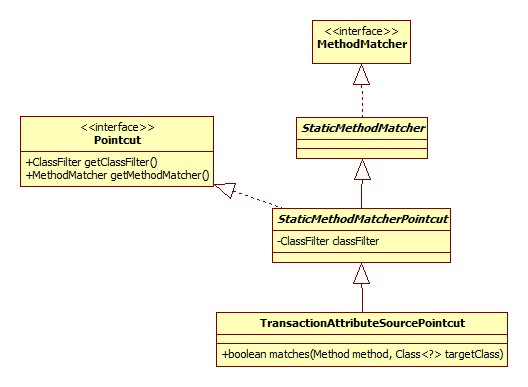
@Override
public Object postProcessAfterInitialization(Object bean, String beanName) throws BeansException {
if (bean != null) {
Object cacheKey = getCacheKey(bean.getClass(), beanName);
if (!this.earlyProxyReferences.contains(cacheKey)) {
return wrapIfNecessary(bean, beanName, cacheKey);
}
}
return bean;
}
protected Object wrapIfNecessary(Object bean, String beanName, Object cacheKey) {
// Create proxy if we have advice.
Object[] specificInterceptors = getAdvicesAndAdvisorsForBean(bean.getClass(), beanName, null);
if (specificInterceptors != DO_NOT_PROXY) {
this.advisedBeans.put(cacheKey, Boolean.TRUE);
Object proxy = createProxy(
bean.getClass(), beanName, specificInterceptors, new SingletonTargetSource(bean));
this.proxyTypes.put(cacheKey, proxy.getClass());
return proxy;
}
}
Advisor寻找
protected List findEligibleAdvisors(Class> beanClass, String beanName) {
List candidateAdvisors = findCandidateAdvisors();
List eligibleAdvisors = findAdvisorsThatCanApply(candidateAdvisors, beanClass, beanName);
extendAdvisors(eligibleAdvisors);
if (!eligibleAdvisors.isEmpty()) {
//按照@Ordered排序
eligibleAdvisors = sortAdvisors(eligibleAdvisors);
}
return eligibleAdvisors;
}
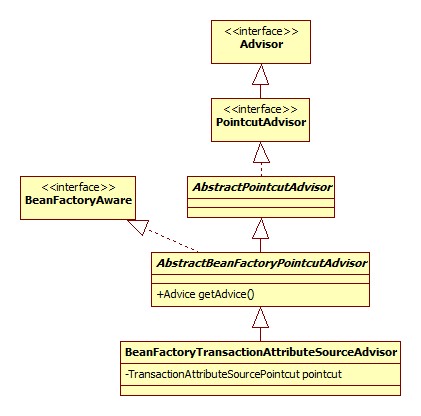
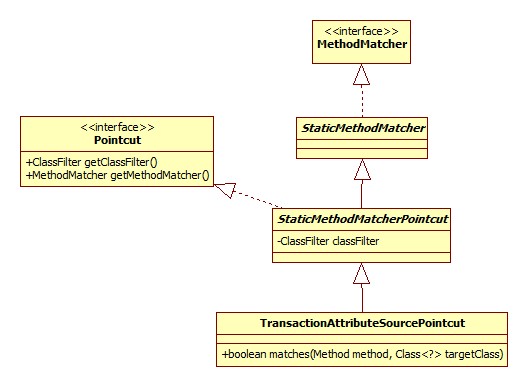
private ClassFilter classFilter = ClassFilter.TRUE;
@Override
public boolean matches(Method method, Class> targetClass) {
//如果已经是事务代理,那么不应该再次代理
if (TransactionalProxy.class.isAssignableFrom(targetClass)) {
return false;
}
TransactionAttributeSource tas = getTransactionAttributeSource();
return (tas == null || tas.getTransactionAttribute(method, targetClass) != null);
}
protected TransactionAttribute computeTransactionAttribute(Method method, Class> targetClass) {
// Don‘t allow no-public methods as required.
if (allowPublicMethodsOnly() && !Modifier.isPublic(method.getModifiers())) {
return null;
}
// Ignore CGLIB subclasses - introspect the actual user class.
Class> userClass = ClassUtils.getUserClass(targetClass);
// The method may be on an interface, but we need attributes from the target class.
// If the target class is null, the method will be unchanged.
Method specificMethod = ClassUtils.getMostSpecificMethod(method, userClass);
// If we are dealing with method with generic parameters, find the original method.
specificMethod = BridgeMethodResolver.findBridgedMethod(specificMethod);
// First try is the method in the target class.
TransactionAttribute txAtt = findTransactionAttribute(specificMethod);
if (txAtt != null) {
return txAtt;
}
// Second try is the transaction attribute on the target class.
txAtt = findTransactionAttribute(specificMethod.getDeclaringClass());
if (txAtt != null && ClassUtils.isUserLevelMethod(method)) {
return txAtt;
}
if (specificMethod != method) {
// Fallback is to look at the original method.
txAtt = findTransactionAttribute(method);
if (txAtt != null) {
return txAtt;
}
// Last fallback is the class of the original method.
txAtt = findTransactionAttribute(method.getDeclaringClass());
if (txAtt != null && ClassUtils.isUserLevelMethod(method)) {
return txAtt;
}
}
return null;
}
运行
@Override
public Object invoke(Object proxy, Method method, Object[] args) throws Throwable {
List调用链生成
@Override
public MethodInterceptor[] getInterceptors(Advisor advisor) throws UnknownAdviceTypeException {
List调用链调用
@Override
public Object proceed() throws Throwable {
if (this.currentInterceptorIndex == this.interceptorsAndDynamicMethodMatchers.size() - 1) {
//拦截器执行完毕,调用原本的方法
return invokeJoinpoint();
}
Object interceptorOrInterceptionAdvice =
this.interceptorsAndDynamicMethodMatchers.get(++this.currentInterceptorIndex);
if (interceptorOrInterceptionAdvice instanceof InterceptorAndDynamicMethodMatcher) {
InterceptorAndDynamicMethodMatcher dm =
(InterceptorAndDynamicMethodMatcher) interceptorOrInterceptionAdvice;
if (dm.methodMatcher.matches(this.method, this.targetClass, this.arguments)) {
return dm.interceptor.invoke(this);
} else {
// Dynamic matching failed.
return proceed();
}
} else {
//调用拦截器的invoke方法
return ((MethodInterceptor) interceptorOrInterceptionAdvice).invoke(this);
}
}
TransactionInterceptor
@Override
public Object invoke(final MethodInvocation invocation) throws Throwable {
Class> targetClass = (invocation.getThis() != null ?
AopUtils.getTargetClass(invocation.getThis()) : null);
// Adapt to TransactionAspectSupport‘s invokeWithinTransaction...
return invokeWithinTransaction(invocation.getMethod(), targetClass, new InvocationCallback() {
@Override
public Object proceedWithInvocation() throws Throwable {
//事务执行完毕后调用链继续向下执行
return invocation.proceed();
}
});
}
protected Object invokeWithinTransaction(Method method, Class> targetClass, final InvocationCallback invocation){
// If the transaction attribute is null, the method is non-transactional.
final TransactionAttribute txAttr = getTransactionAttributeSource()
.getTransactionAttribute(method, targetClass);
final PlatformTransactionManager tm = determineTransactionManager(txAttr);
//得到方法名
final String joinpointIdentification = methodIdentification(method, targetClass);
if (txAttr == null || !(tm instanceof CallbackPreferringPlatformTransactionManager)) {
// Standard transaction demarcation with getTransaction and commit/rollback calls.
TransactionInfo txInfo = createTransactionIfNecessary(tm, txAttr, joinpointIdentification);
Object retVal = null;
try {
// This is an around advice: Invoke the next interceptor in the chain.
// This will normally result in a target object being invoked.
retVal = invocation.proceedWithInvocation();
} catch (Throwable ex) {
// target invocation exception
completeTransactionAfterThrowing(txInfo, ex);
throw ex;
} finally {
cleanupTransactionInfo(txInfo);
}
commitTransactionAfterReturning(txInfo);
return retVal;
}
}
事务管理器
protected PlatformTransactionManager determineTransactionManager(TransactionAttribute txAttr) {
//如果没有事务属性,那么仅从缓存中查找,找不到返回null
if (txAttr == null || this.beanFactory == null) {
return getTransactionManager();
}
String qualifier = txAttr.getQualifier();
//如果@Transactional注解配置了transactionManager或value属性(用以决定使用哪个事务管理器):
//首先查找缓存,找不到再去容器中按名称寻找
if (StringUtils.hasText(qualifier)) {
return determineQualifiedTransactionManager(qualifier);
} else if (StringUtils.hasText(this.transactionManagerBeanName)) {
return determineQualifiedTransactionManager(this.transactionManagerBeanName);
} else {
//去容器中按类型(Class)查找
PlatformTransactionManager defaultTransactionManager = getTransactionManager();
if (defaultTransactionManager == null) {
defaultTransactionManager = this.beanFactory.getBean(PlatformTransactionManager.class);
this.transactionManagerCache.putIfAbsent(
DEFAULT_TRANSACTION_MANAGER_KEY, defaultTransactionManager);
}
return defaultTransactionManager;
}
}
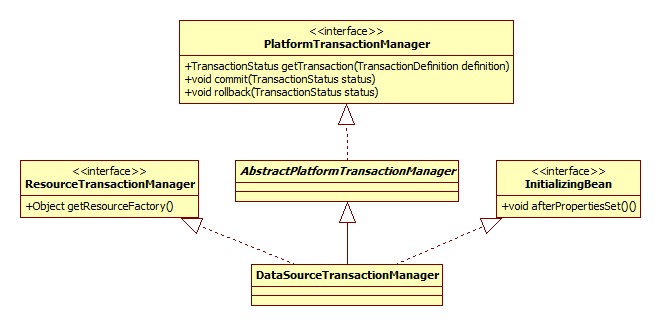
DataSource
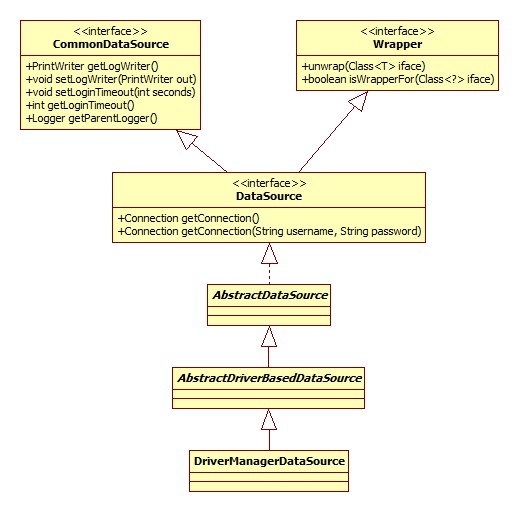
事务开启
protected TransactionInfo createTransactionIfNecessary(
PlatformTransactionManager tm, TransactionAttribute txAttr, final String joinpointIdentification) {
// If no name specified, apply method identification as transaction name.
if (txAttr != null && txAttr.getName() == null) {
txAttr = new DelegatingTransactionAttribute(txAttr) {
@Override
public String getName() {
return joinpointIdentification;
}
};
}
TransactionStatus status = null;
if (txAttr != null) {
if (tm != null) {
status = tm.getTransaction(txAttr);
}
}
return prepareTransactionInfo(tm, txAttr, joinpointIdentification, status);
}
是否已存在事务
private static Object doGetResource(Object actualKey) {
Mapprivate static final ThreadLocal事务已存在
PROPAGATION_NEVER
if (definition.getPropagationBehavior() == TransactionDefinition.PROPAGATION_NEVER) {
throw new IllegalTransactionStateException(
"Existing transaction found for transaction marked with propagation ‘never‘");
}
PROPAGATION_NOT_SUPPORTED
if (definition.getPropagationBehavior() == TransactionDefinition.PROPAGATION_NOT_SUPPORTED) {
Object suspendedResources = suspend(transaction);
boolean newSynchronization = (getTransactionSynchronization() == SYNCHRONIZATION_ALWAYS);
return prepareTransactionStatus(
definition, null, false, newSynchronization, debugEnabled, suspendedResources);
}
事务挂起
private static Object doUnbindResource(Object actualKey) {
Map@Override
protected Object doSuspend(Object transaction) {
DataSourceTransactionObject txObject = (DataSourceTransactionObject) transaction;
txObject.setConnectionHolder(null);
ConnectionHolder conHolder = (ConnectionHolder)
TransactionSynchronizationManager.unbindResource(this.dataSource);
return conHolder;
}
PROPAGATION_REQUIRES_NEW
if (definition.getPropagationBehavior() == TransactionDefinition.PROPAGATION_REQUIRES_NEW) {
SuspendedResourcesHolder suspendedResources = suspend(transaction);
boolean newSynchronization = (getTransactionSynchronization() != SYNCHRONIZATION_NEVER);
DefaultTransactionStatus status = newTransactionStatus(
definition, transaction, true, newSynchronization, debugEnabled, suspendedResources);
doBegin(transaction, definition);
prepareSynchronization(status, definition);
return status;
}
PROPAGATION_NESTED
if (definition.getPropagationBehavior() == TransactionDefinition.PROPAGATION_NESTED) {
if (useSavepointForNestedTransaction()) {
// Create savepoint within existing Spring-managed transaction,
// through the SavepointManager API implemented by TransactionStatus.
// Usually uses JDBC 3.0 savepoints. Never activates Spring synchronization.
DefaultTransactionStatus status =
prepareTransactionStatus(definition, transaction, false, false, debugEnabled, null);
status.createAndHoldSavepoint();
return status;
}
}
public void createAndHoldSavepoint() throws TransactionException {
setSavepoint(getSavepointManager().createSavepoint());
}
@Override
protected SavepointManager getSavepointManager() {
if (!isTransactionSavepointManager()) {
throw new NestedTransactionNotSupportedException(
"Transaction object [" + getTransaction() + "] does not support savepoints");
}
return (SavepointManager) getTransaction();
}
debug环境搭建
@Component
public class TransactionBean {
private NestedBean nestedBean;
public NestedBean getNestedBean() {
return nestedBean;
}
public void setNestedBean(NestedBean nestedBean) {
this.nestedBean = nestedBean;
}
@Transactional(propagation = Propagation.REQUIRED)
public void process() {
System.out.println("事务执行");
nestedBean.nest();
}
}
@Component
public class NestedBean {
@Transactional(propagation = Propagation.NESTED)
public void nest() {
System.out.println("嵌套事务");
}
}
public static void main(String[] args) {
ClassPathXmlApplicationContext context = new ClassPathXmlApplicationContext("config.xml");
TransactionBean bean = context.getBean(TransactionBean.class);
bean.process();
}
事务对象
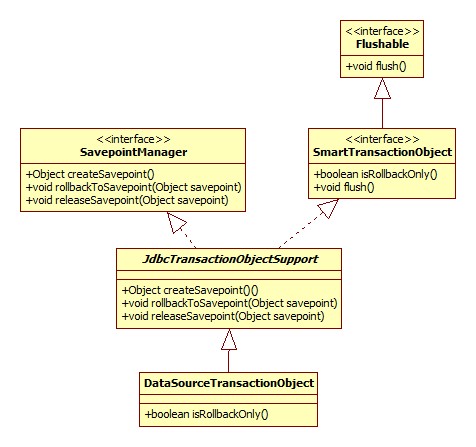
Savepoint
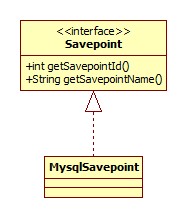
@Override
public Object createSavepoint() throws TransactionException {
ConnectionHolder conHolder = getConnectionHolderForSavepoint();
return conHolder.createSavepoint();
}
public Savepoint createSavepoint() throws SQLException {
this.savepointCounter++;
return getConnection().setSavepoint(SAVEPOINT_NAME_PREFIX + this.savepointCounter);
}
savepoint xx可以看出这一点。其它
事务创建
@Override
protected void doBegin(Object transaction, TransactionDefinition definition) {
//此时,txObject不为null,只是其核心的ConnectHolder属性为null
DataSourceTransactionObject txObject = (DataSourceTransactionObject) transaction;
Connection con = null;
if (txObject.getConnectionHolder() == null ||
txObject.getConnectionHolder().isSynchronizedWithTransaction()) {
Connection newCon = this.dataSource.getConnection();
//获得连接,可以看出ConnectionHolder是对Connection的包装
txObject.setConnectionHolder(new ConnectionHolder(newCon), true);
}
txObject.getConnectionHolder().setSynchronizedWithTransaction(true);
con = txObject.getConnectionHolder().getConnection();
//设置是否只读和隔离级别
Integer previousIsolationLevel = DataSourceUtils.prepareConnectionForTransaction(con, definition);
txObject.setPreviousIsolationLevel(previousIsolationLevel);
// Switch to manual commit if necessary. This is very expensive in some JDBC drivers,
// so we don‘t want to do it unnecessarily (for example if we‘ve explicitly
// configured the connection pool to set it already).
if (con.getAutoCommit()) {
txObject.setMustRestoreAutoCommit(true);
con.setAutoCommit(false);
}
txObject.getConnectionHolder().setTransactionActive(true);
int timeout = determineTimeout(definition);
if (timeout != TransactionDefinition.TIMEOUT_DEFAULT) {
txObject.getConnectionHolder().setTimeoutInSeconds(timeout);
}
// Bind the session holder to the thread.
if (txObject.isNewConnectionHolder()) {
TransactionSynchronizationManager.bindResource(getDataSource(), txObject.getConnectionHolder());
}
}
事务提交 & 回滚
总结